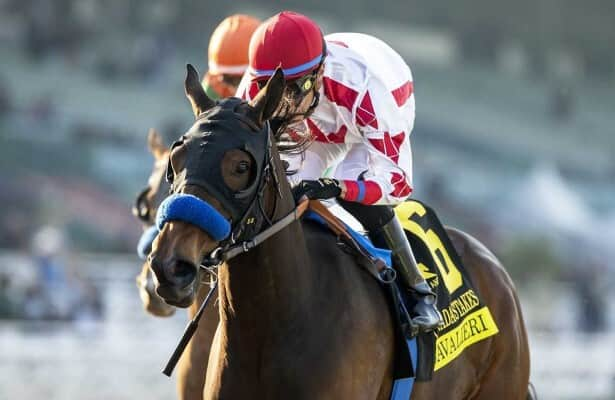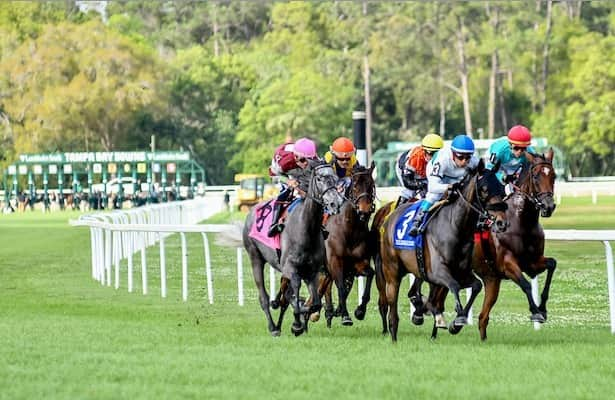Waiting for the shoes to drop

by Debbie Little
Years ago, a trainer told me, “We are in the gambling business.” That may be true, but we are also in the business of racing horses to win.
I will freely admit that I have not been gambling consistently for quite a while. But just because I haven’t placed a $200 win bet recently doesn’t mean that I can’t relate to the frustration that one feels when they are unaware of late equipment changes.
There has been a lot of back and forth on social media since Dean Towers’ column, “Reporting of equipment changes needs a major reboot,” ran last week in HRU. No surprise, the gamblers and horsepeople see the situation a little differently.
Towers suggested that trainers share their intentions as “Possible No Shoes” on the equipment change list that’s sent out before race 1, and, if indeed the shoes are pulled, it would need to be shared by the track with all interested parties, including on social media and their in-house show.
On X (formerly known as Twitter), as well as on Facebook, some gamblers said they would prefer an equipment change deadline prior to the first race, after which no modifications would be made. This cut off was not chosen arbitrarily since the Pick-5 at The Meadowlands starts in race 1.
Several gamblers also shared online that if they knew a trainer was pulling shoes, they would include that horse in their multi-leg wagers, even if they probably wouldn’t have solely based on past performances.
HRU reached out to several Meadowlands trainers — Tony Alagna, Ron Burke, Noel Daley, Nifty Norman, Sarah Svanstedt, Nancy Takter, and Linda Toscano — and simply asked, “If you are planning to pull shoes, would you always know you were going to do it before the start of the card?”
“With me, I prefer to see the track,” Burke said. “The later, the better. Trainer responsibility goes both ways and mine is to do the best by the horse.”
Toscano said, “It’s always a thought but you’re never sure until after warm-ups.”
Warming up their horses seemed to be a common deciding factor for trainers when it comes to equipment changes, especially when pulling shoes.
“A lot depends on warm-up and track conditions,” Daley said. “If we were allowed to advise after warm-up, that’s perfect.”
Alagna said, “Generally, it will depend on the track surface after we warm up. That is generally when I will decide to pull shoes with certainty.”
Norman agreed that the track surface is a factor, but then went one step further.
“It’s definitely a decision you can’t make until you’ve seen the state of the track and maybe even warm the horse up,” Norman said. “In my opinion, pulling the shoes probably backfires as often as it is successful.”
Since the situation that sparked Towers to write his column happened at Woodbine Mohawk Park, I also asked trainer Blair Burgess the same question.
Burgess has pulled shoes in the past and shared a story about doing so a while back at The Meadowlands.
“Its reputation may exceed the value somewhat,” Burgess said. “I trained one for [Ake] Svandstedt, 10 or 12 years ago, and raced in a stake at The Big M. He came to drive and wanted the shoes off after warm-up. He rolled the horse on the front end and made a break in the stretch. Some trotters may miss the weight up front or get foot-sore as the race gets near end. But Svandstedt really loves it. Maybe more than even other Swedes.”
It was also mentioned on social media that tracks in Europe are always good and allow for pulling shoes, but that track surfaces in the U.S. are very inconsistent.
Born in Sweden, Takter said most trainers probably know if they’re leaning towards pulling shoes.
“Well, I would say you have an idea that you’re going to do it because the horse cannot be newly shod when you pull the shoes or you will make the horse’s feet bleed, so you have to have a little preparation before you do it,” Takter said.
When it comes to the aforementioned Pick-5, no matter how cooperative the trainers may want to be with sharing information, it would be hard for them to be definitive about changes when the horses in the fifth race probably wouldn’t warm up until after the first.
Sarah Svanstedt shared what her experiences were in her native country.
“In Sweden, there was a sheet in the paddock area where the trainer could mark ‘barefoot’ one hour prior to the race the horse was in,” Sarah said. “It was always possible to change back to shoes-on if the track was not in good condition.
“You need to get a chance to warm up on the track before a 100 per cent decision can be made.”
In Pathway on the USTA website under the “facility summary rulings report,” since 2019, The Meadowlands has only had four offenders — two each in 2021 and 2022 — for failure to report equipment change. In fact, in the last 20 years at The Big M, there were only a total of eight offenders; the four mentioned and two each in 2009 and 2010. It is unclear if any of these were for pulling shoes because the report does not have any details. However, this does not mean that more late equipment changes didn’t happen, just that no one was penalized.
As with anything starting from scratch, it would seem that there will be growing pains as tracks attempt to find a way to keep both their customers and their horsepeople happy.
Asking trainers to sign a sheet with their early intentions upon entering the paddock doesn’t seem to be too outrageous, but following up closer to race time may need to be examined a little more.
Since many times trainers have horses in multiple races, it might be best for the track to take responsibility and have someone in the paddock to ask the trainers between warm-ups what their plans are and then share that info.
One hundred per cent adherence may not be a shoo-in, but at least it’s a start.
“The Commissions need to find a compromise fair to trainers and bettors,” Burgess said. “Possibly on all equipment changes, not just shoes. We have to be trainers. Conditions and horses change in time as a race card runs. I like Dean Towers’ compromise in HRU. Have two equipment-change times. An early one (at time of entry or first post) that states ‘possibility of shoes off’ and then a change can be made official one hour before the actual event.
“Refunds on early bets are an option for punters that don’t like the change, and new players can jump in that like the change. Either way, bettors can’t complain they didn’t know.”
Related
Leading Parx jockey Sanchez will serve 7-day suspension
Photo: Jason Moran / Eclipse Sportswire Jockey Mychel Sanchez will serve a seven-day suspension and pay an additional $1,750 in fines
Bill Mott talks about plans for Sovereignty, Just F Y…
Photo: Gulfstream Park / Lauren King Sovereignty, dramatic late-running winner of the Fountain of Youth (G2) March 1, is being pointed
Up-and-coming Cavalieri chases Grade 1 glory in Beholder Mile
Photo: Santa Anita / Benoit Photo Cavalieri and Alpha Bella, who finished one-two in the Grade 3 La Cañada in January at Santa Anita,
4 stakes showcase shipping stars on Tampa Bay undercard
Photo: Gonzalo Anteliz Jr. / Eclipse Sportswire The stars will shine Saturday at Tampa Bay Downs, and not just in the Grade 3 Tampa Ba











